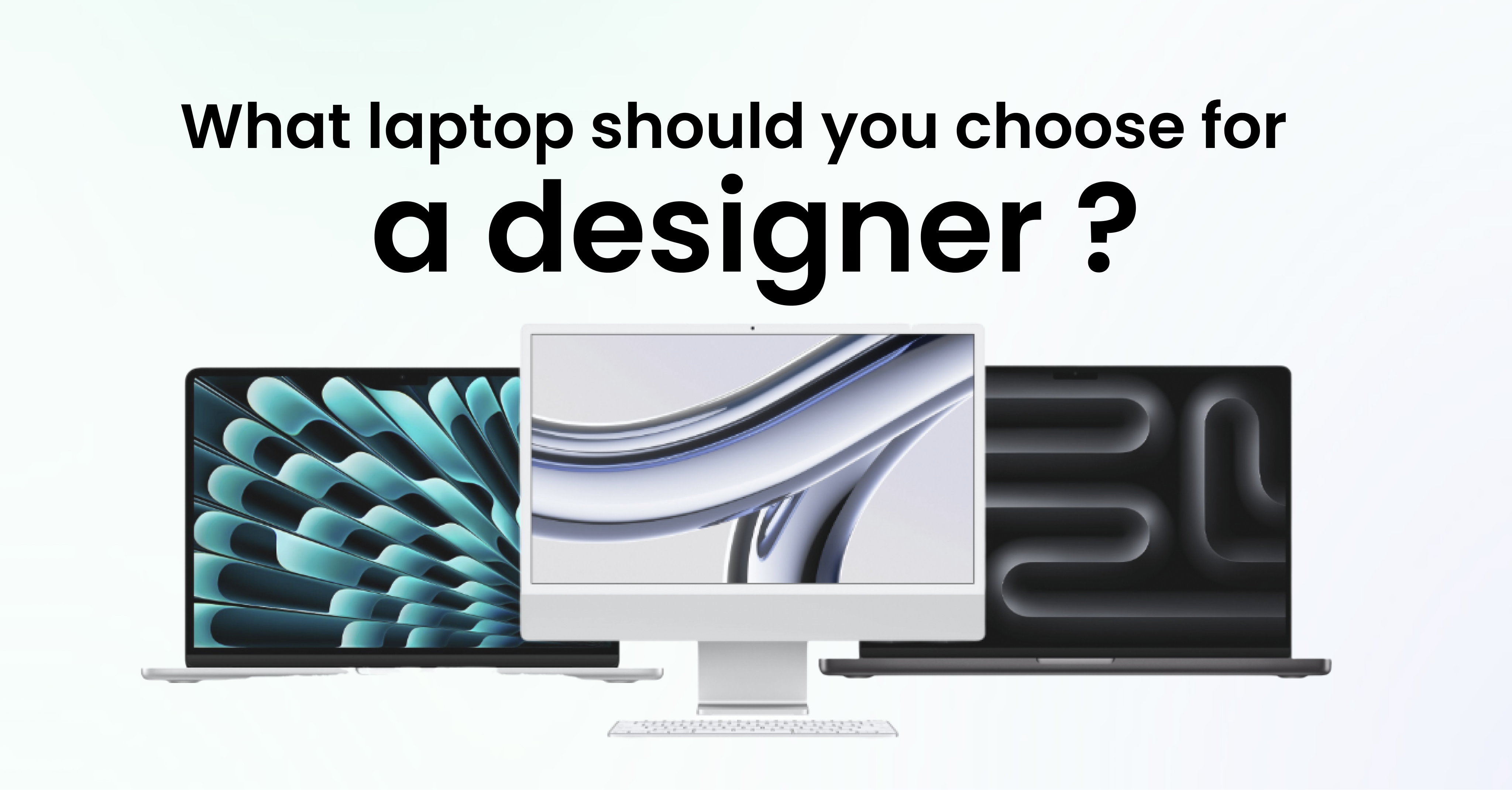Summary
You too, can equip your employees simply with Fleet
Focus on your growth by choosing our all-in-one solution.
What usage?
Graphic design requires high-performance hardware and software, such as the Adobe suite, which includes several software and online tools dedicated to creation (InDesign, Illustrator, Premiere Pro, LightRoom...). Therefore, several criteria must be considered when choosing a computer for your graphic designer or designer: screen quality, size, resolution, and power to run the software and storage to keep large files. The usage and working style of your collaborator also play a role in the choice of equipment.
Desktop or Laptop?
A desktop computer will be ideal for maximum comfort thanks to its large screen. However, it will be much less practical for mobility. It is recommended to equip your graphic designer or designer with a fixed screen at their workstation. A laptop now combines power and portability, ideal for your “nomadic” collaborators or those alternating between in-person and remote work. It is highly recommended to provide your designer with a second fixed screen, which will offer additional comfort, even a third!
MacOS, Windows?
Your collaborator can do graphic design on any type of operating system, according to their preferences and comfort. The MacOS operating system is ideal for hosting the Adobe suite, but Windows offers very powerful laptop models for graphic design, such as the Elitebook. Find our selection of computers at the bottom of this article.
Essential Technical Characteristics of a PC for a Graphic Designer
Which Processor?
What is it?
The processor defines the number of instructions (commands) the computer can execute each second. The more powerful the processor, the faster the computer will be on heavy tasks. Note that this does not change the download speed of pages and files, which mainly depends on the quality of the internet connection.
Which one to choose?
If your employee works on the Adobe Suite or other Design software, it is preferable to opt for an i7 or i9 processor for Intel, or M1 and M2 for MacBook, with a speed of 2 GHz or more.
Which RAM?
What is it?
RAM is the computer’s memory. The higher its capacity, the faster the computer will be and the more capable of running a large number of software or applications simultaneously.
Which one to choose?
Opt for a minimum of 8 GB or 16 GB of RAM. The Adobe suite recommends at least 8GB to run its software.
Which Storage?
What is it?
Storage is the component of your computer that allows you to keep files, download applications, and perform updates.
Which one to choose?
Prefer an SSD, now present in most models, ideal for storing the operating system (Windows, Mac OS) and frequently used programs. Faster than mechanical drives, the recommended minimum size is 512 GB for a designer. Ideal for storing creations but also the software which is, for the most part, very large.
Which Screen?
It is imperative to offer your graphic designer a high-quality screen. Opt for a screen of at least 15 inches, preferably Retina for a better rendering of creations and good color representation. Prefer a desktop computer with a large screen, accompanied by a second fixed screen to combine practicality, ergonomics, and productivity. Some graphic designers and designers will prefer a laptop with a large screen for more mobility, especially in telecommuting: in this case, choose at least a 15-inch or a touchscreen with a two-in-one tablet computer.
Graphics Card and Resolution:
What is it?
The graphics card is a component of the central unit that produces an image displayable on a screen. The resolution indicates the pixel density of an image.
Which ones to choose?
A standard graphics card is sufficient, very often already integrated into computers. On most current computers, processors are composed of dedicated cores that manage the display of the image on the screen (this is the case with the new MacBooks M1 and M2). For more advanced uses such as 3D, it can be useful to have a powerful external graphics chip. For graphic creation, it is not necessary to have a screen with a huge resolution.
And Accessories?
To maximize the comfort of your collaborator, do not hesitate to provide: A laptop stand: to avoid spending the day hunched over and to position the computer at the correct eye height. An adapted keyboard: you can opt for an ergonomic keyboard that will allow your collaborator to adopt a better posture and avoid wrist pain. A second screen: for assured visual comfort and better visibility of creations. A drawing tablet or artistic tablet: this accessory will allow your graphic designer to draw directly on it using a stylus, making it easier to create and integrate their drawings directly into their software creations, or send them for validation more easily. A headset: if your collaborator works on video creation, it is essential to provide them with a good, comfortable headset, preferably wireless.
To Summarize:
A laptop or desktop computer with a second screen A screen of at least 15 inches for a laptop A processor M1 or M2 on Mac, Intel i7 or higher on PC 8 GB or 16 GB of RAM A standard graphics card often already integrated A minimum storage space of 512 GB (SSD format is a plus) Accessories to promote the comfort and productivity of your collaborator
Which Model of Computer or PC to Choose?
Here is a selection of computers suitable for a graphic designer, designer, or videographer position, taking into account the various criteria mentioned:
MacBook Pro 16" M3 - __Learn more

iMac Retina 24" M3 - Learn more

MacBook Air M3 15' - Learn more

Optiplex 24' - Learn more



